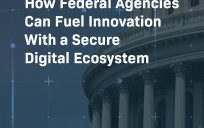This post is an excerpt from our recent report, “Finding Your Right Cloud Solution: Public & Private Clouds.” To download the full report, click here. The report is part of a three-part series, where GovLoop will highlight the power of the Oracle cloud and explore how Oracle is helping government agencies transform the way they deliver services.
As an information technology (IT) professional, you spend significant time purchasing, managing, upgrading and administering IT services. Often, these responsibilities are time-consuming and pull you away from fulfilling the most important mission-critical objectives at your agency. That’s why many IT departments have looked to the cloud to transform their operations. From the field worker to the database manager, it’s cloud technology that has led to a radical shift in the way organizations conduct business.
Today, business processes are more streamlined, efficient and agile, and the impact of the cloud has only just begun. Take, for instance, the State of Texas, a public sector leader in leveraging cloud technology. To help various agencies across the state deploy the cloud, the Texas Department of Information Resources (DIR) created a cloud marketplace. Powered by a private cloud built with Oracle’s Exadata and Exalogic Engineered Systems, the marketplace expedites and streamlines the process to procure database services for state agencies. Now, Texas state agencies are using the cloud to deploy new kinds of IT delivery models, which are reducing costs, meeting efficiency targets and end-user demands from citizens and employees, and assisting in maintaining compliance requirements (such as records retention).
But Texas is certainly not alone in their deployment of cloud. An Oracle white paper reports that the use of cloud computing is growing at a compound annual growth rate of 26 percent. And, a recent Deloitte report predicts that in 2020 cloud computing is expected to account for 18 percent of the global IT market (excluding IT services and client devices). Leveraging Oracle solutions, the public sector can deploy a complete cloud solution.
Agencies must consider a variety of different solutions. One of the key decisions is to select a public or private deployment model. Four common cloud deployment models are public, private, hybrid, and community cloud. Each deployment model is different and dictates where services are hosted; who has access to data and information; who is managing the cloud; and customization of services.
- The Public Cloud: A public cloud is a cloud deployment built and managed by a Cloud Service Provider (CSP). Customers have limited visibility into the architecture of the service and cannot specify particular security protocols or service offerings. These are chosen by the CSP for all customers.
- The Private Cloud: A private cloud is a cloud deployment that is used exclusively for one customer. The customer can define everything about the cloud: the infrastructure, the security, the service offerings, the service level objectives. This does not mean the customer has to own or manage the cloud themselves, it just means it is exclusively under their control.
- The Hybrid Cloud: Consists of two or more deployment models. For instance, a hybrid cloud will contain both a public and private cloud and can easily segment data and transfer data between clouds as necessary
- The Community Cloud: A community cloud is a model that provides access to multiple organizations that have similar interests in collaboration. This may look like a private cloud for one government organization, and a public cloud to other government organizations that share the services in the community cloud.
“Before you make a decision, you should understand what the business drivers are so you don’t go with a public cloud solution when you should go private cloud, or vice versa,” advised Aaron Erickson, Director Government Innovation, Oracle. “You must understand what the drivers are and how to make the right decision.”





Leave a Reply
You must be logged in to post a comment.